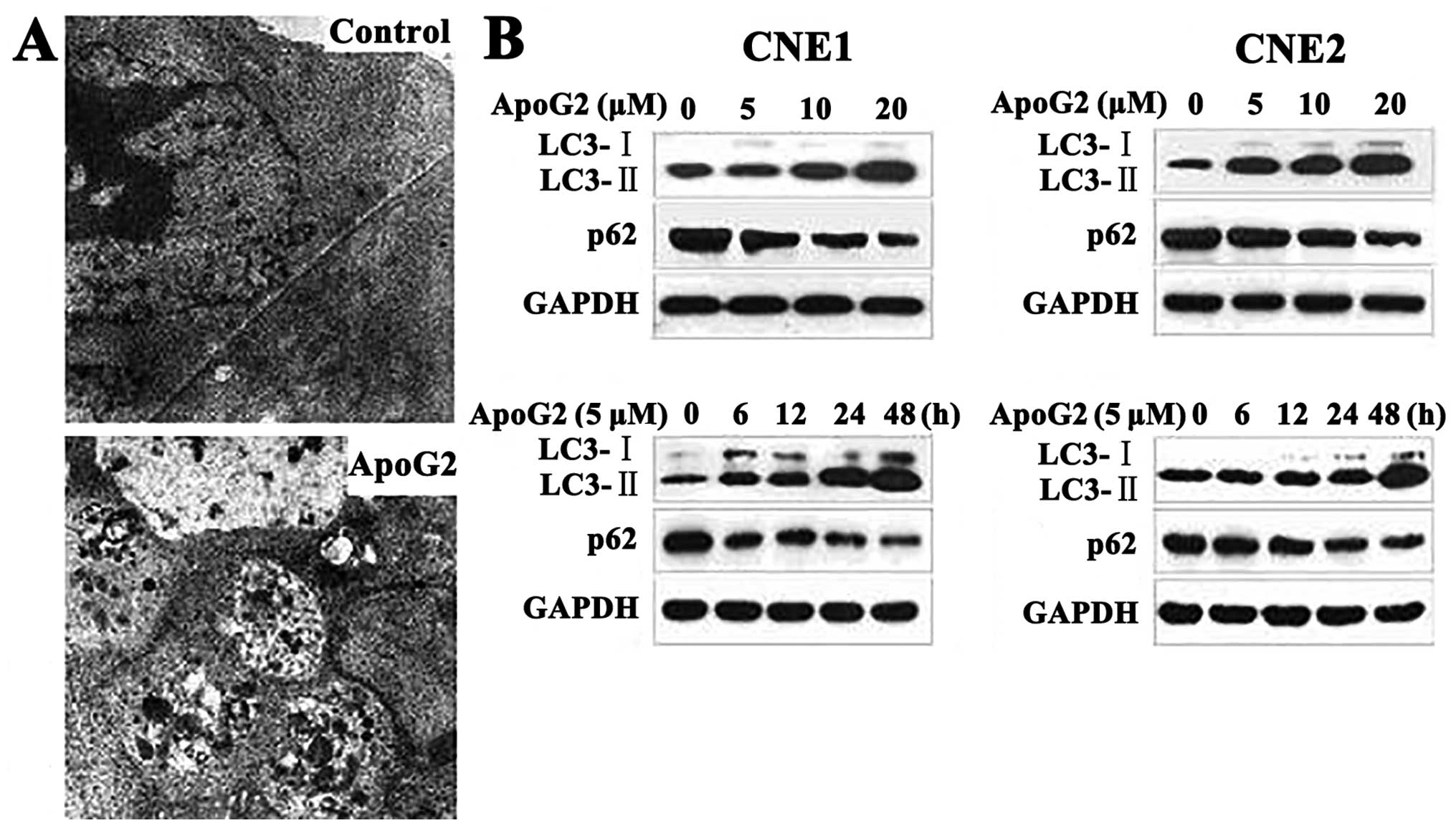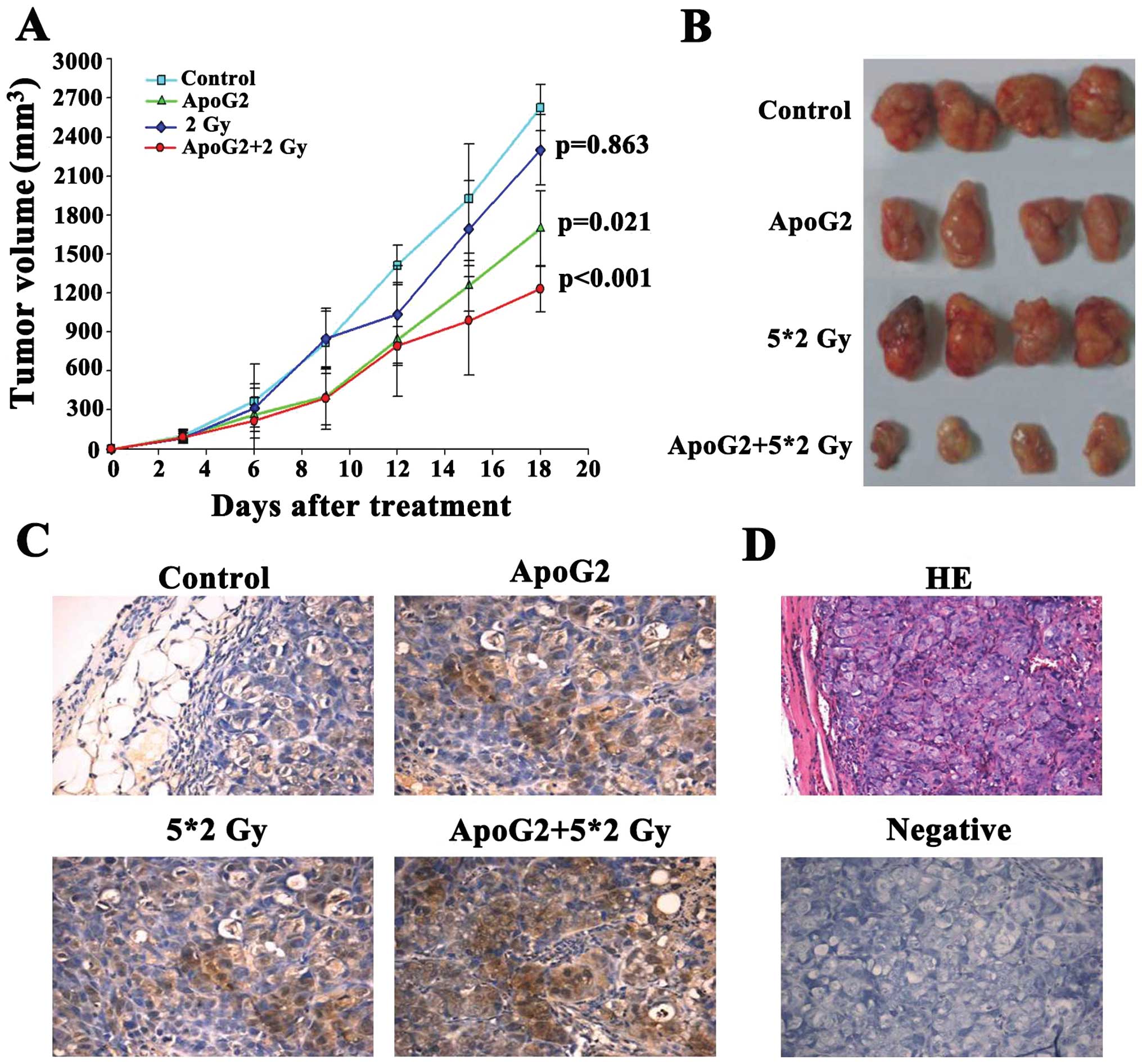|
1
|
McDermott AL, Dutt SN and Watkinson JC:
The aetiology of nasopharyngeal carcinoma. Clin Otolaryngol Allied
Sci. 26:82–92. 2001. View Article : Google Scholar : PubMed/NCBI
|
|
2
|
Bei JX, Jia WH and Zeng YX: Familial and
large-scale case-control studies identify genes associated with
nasopharyngeal carcinoma. Semin Cancer Biol. 22:96–106. 2012.
View Article : Google Scholar : PubMed/NCBI
|
|
3
|
Lee AW, Lin JC and Ng WT: Current
management of nasopharyngeal cancer. Semin Radiat Oncol.
22:233–244. 2012. View Article : Google Scholar : PubMed/NCBI
|
|
4
|
Yoshizaki T, Ito M, Murono S, Wakisaka N,
Kondo S and Endo K: Current understanding and management of
nasopharyngeal carcinoma. Auris Nasus Larynx. 39:137–144. 2012.
View Article : Google Scholar
|
|
5
|
Kang MH and Reynolds CP: Bcl-2 inhibitors:
targeting mitochondrial apoptotic pathways in cancer therapy. Clin
Cancer Res. 15:1126–1132. 2009. View Article : Google Scholar : PubMed/NCBI
|
|
6
|
Zhou FF, Yang Y and Xing D: Bcl-2 and
Bcl-xL play important roles in the crosstalk between autophagy and
apoptosis. FEBS J. 278:403–413. 2011. View Article : Google Scholar : PubMed/NCBI
|
|
7
|
Levine B, Sinha S and Kroemer G: Bcl-2
family members: dual regulators of apoptosis and autophagy.
Autophagy. 4:600–606. 2008. View Article : Google Scholar : PubMed/NCBI
|
|
8
|
Green DR and Evan GI: A matter of life and
death. Cancer Cell. 1:19–30. 2002. View Article : Google Scholar
|
|
9
|
Lu QL, Elia G, Lucas S and Thomas JA:
Bcl-2 proto-oncogene expression in Epstein-Barr-virus-associated
nasopharyngeal carcinoma. Int J Cancer. 53:29–35. 1993. View Article : Google Scholar : PubMed/NCBI
|
|
10
|
Fan SQ, Ma J, Zhou J, Xiong W, Xiao BY,
Zhang WL, Tan C, Li XL, Shen SR, Zhou M, Zhang QH and Ou YJ:
Differential expression of Epstein-Barr virus-encoded RNA and
several tumor-related genes in various types of nasopharyngeal
epithelial lesions and nasopharyngeal carcinoma using tissue
microarray analysis. Hum Pathol. 37:593–605. 2006. View Article : Google Scholar
|
|
11
|
Sheu LF, Chen A, Meng CL, Ho KC, Lin FG
and Lee WH: Analysis of bcl-2 expression in normal, inflamed,
dysplastic nasopharyngeal epithelia, and nasopharyngeal carcinoma:
association with p53 expression. Hum Pathol. 28:556–562. 1997.
View Article : Google Scholar
|
|
12
|
Yu Y, Dong W, Li X, Yu E, Zhou X and Li S:
Significance of c-Myc and Bcl-2 protein expression in
nasopharyngeal carcinoma. Arch Otolaryngol Head Neck Surg.
129:1322–1326. 2003. View Article : Google Scholar : PubMed/NCBI
|
|
13
|
Hu ZY, Zhu XF, Zhong ZD, Sun J, Wang J,
Yang D and Zeng YX: ApoG2, a novel inhibitor of antiapoptotic Bcl-2
family proteins, induces apoptosis and suppresses tumor growth in
nasopharyngeal carcinoma xenografts. Int J Cancer. 123:2418–2429.
2008. View Article : Google Scholar
|
|
14
|
Del Poeta G, Venditti A, Del Principe MI,
et al: Amount of spontaneous apoptosis detected by Bax/Bcl-2 ratio
predicts outcome in acute myeloid leukemia (AML). Blood.
101:2125–2131. 2003.PubMed/NCBI
|
|
15
|
Minn AJ, Rudin CM, Boise LH and Thompson
CB: Expression of bcl-xL can confer a multidrug resistance
phenotype. Blood. 86:1903–1910. 1995.PubMed/NCBI
|
|
16
|
Yoshino T, Shiina H, Urakami S, et al:
Bcl-2 expression as a predictive marker of hormone-refractory
prostate cancer treated with taxane-based chemotherapy. Clin Cancer
Res. 12:6116–6124. 2006. View Article : Google Scholar : PubMed/NCBI
|
|
17
|
Lacy J, Loomis R, Grill S, Srimatkandada
P, Carbone R and Cheng YC: Systemic Bcl-2 antisense
oligodeoxynucleotide in combination with cisplatin cures EBV1
nasopharyngeal carcinoma xenografts in SCID mice. Int J Cancer.
119:309–316. 2006. View Article : Google Scholar : PubMed/NCBI
|
|
18
|
Oltersdorf T, Elmore SW, Shoemaker AR,
Armstrong RC, Augeri DJ, Belli BA, Bruncko M, Deckwerth TL, Dinges
J, Hajduk PJ, Joseph MK and Kitada S: An inhibitor of Bcl-2 family
proteins induces regression of solid tumours. Nature. 435:677–681.
2005. View Article : Google Scholar : PubMed/NCBI
|
|
19
|
Kang MH, Wan Z, Kang Y, Sposto R and
Reynolds CP: Mechanism of synergy of N-(4-hydroxyphenyl) retinamide
and ABT-737 in acute lymphoblastic leukemia cell lines:
Mcl-1inactivation. J Natl Cancer Inst. 100:580–595. 2008.
View Article : Google Scholar : PubMed/NCBI
|
|
20
|
Konopleva M, Contractor R, Tsao T, et al:
Mechanisms of apoptosis sensitivity and resistance to the BH3
mimetic ABT-737 in acute myeloid leukemia. Cancer Cell. 10:375–388.
2006. View Article : Google Scholar : PubMed/NCBI
|
|
21
|
Chauhan D, Velankar M, Brahmandam M, et
al: A novel Bcl-2/Bcl-X(L)/Bcl-w inhibitor ABT-737 as therapy in
multiple myeloma. Oncogene. 26:2374–2380. 2006. View Article : Google Scholar : PubMed/NCBI
|
|
22
|
Van Delft MF, Wei AH, Mason KD, et al: The
BH3 efficiently induces apoptosis via Bak/Bax if Mcl-1 is
neutralized. Cancer Cell. 10:389–399. 2006.PubMed/NCBI
|
|
23
|
Del Gaizo Moore V, Brown JR, Certo M, Love
TM, Novina CD and Letai A: Chronic lymphocytic leukemia requires
BCL2 to sequester prodeath BIM, explaining sensitivity to BCL2
antagonist ABT-737. J Clin Invest. 117:112–121. 2007.PubMed/NCBI
|
|
24
|
Lin X, Morgan-Lappe S and Huang X: ‘Seed’
analysis of off-target siRNAs reveals an essential role of Mcl-1 in
resistance to the small-molecule Bcl-2/Bcl-X(L) inhibitorABT-737.
Oncogene. 26:3972–3979. 2007.
|
|
25
|
Hann CL, Daniel VC, Sugar EA,
Dobromilskaya I, Murphy SC, Cope L, Lin X, Hierman JS, Wilburn DL,
Watkins DN and Rudin CM: Therapeutic efficacy of ABT-737, a
selective inhibitor of BCL-2, in small cell lung cancer. Cancer
Res. 68:2321–2328. 2008. View Article : Google Scholar : PubMed/NCBI
|
|
26
|
MacVicar GR, Kuzel TM and Curti BD: An
open label, multicenter, phase I/II study of AT-101 in combination
with docetaxel (D) and prednisone (P) in men with hormone
refractory prostate cancer (HRPC). J Clin Oncol. 26:160482008.
|
|
27
|
Yang D, Chen J, Xu L, Gao W, Guo J, Qiu S,
Holmlund J, Sorensen M and Wang S: AT-101 and ApoG2, highly potent
and orally active small molecule inhibitors of Mcl-1 protein and
potential application for apoptosis-targeted anticancer therapy.
AACR-NCI-EORCT International Conference on Molecular Targets and
Cancer Therapeutics; pp. 255abs. 223. Nov 14–18 2005; http://www.aacr.org/Uploads/DocumentRepository/pdf_files/2005MTCT/MT05_abstracts_C.pdf.
|
|
28
|
Arnold AA, Aboukameel A, Chen J, Yang D
and Wang S: Preclinical studies of Apogossypolone: a new
nonpeptidic pan small-molecule inhibitor of Bcl-2, Bcl-XL and Mcl-1
proteins in Follicular Small Cleaved Cell Lymphoma model. Mol
Cancer. 7:202008. View Article : Google Scholar : PubMed/NCBI
|
|
29
|
Dao VT, Dowd MK, Martin MT, Gaspard C,
Mayer M and Michelot RJ: Cytotoxicity of enantiomers of gossypol
Schiff’s bases and optical stability of gossypolone. Eur J Med
Chem. 39:619–624. 2004.PubMed/NCBI
|
|
30
|
Sun J, Li ZM, Hu ZY, Lin XB, Zhou NN, Xian
LJ, Yang DJ and Jiang WQ: ApoG2 inhibits antiapoptotic Bcl-2 family
proteins and induces mitochondria-dependent apoptosis in human
lymphoma U937 cells. Anticancer Drugs. 19:967–974. 2008. View Article : Google Scholar : PubMed/NCBI
|
|
31
|
Zhang XQ, Huang XF, Hu XB, Zhan YH, An QX,
Yang SM, Xia AJ, Yi J, Chen R, Mu SJ and Wu DC: Apogossypolone, a
novel inhibitor of antiapoptotic Bcl-2 family proteins, induces
autophagy of PC-3 and LNCaP prostate cancer cells in vitro. Asian J
Androl. 12:697–708. 2010. View Article : Google Scholar : PubMed/NCBI
|
|
32
|
Hu ZY, Sun J, Zhu XF, Yang D and Zeng YX:
ApoG2 induces cell cycle arrest of nasopharyngeal carcinoma cells
by suppressing the c-Myc signaling pathway. J Transl Med. 7:742009.
View Article : Google Scholar : PubMed/NCBI
|
|
33
|
Zhou WJ, Deng R, Zhang XY, Feng GK, Gu LQ
and Zhu XF: G-quadruplex ligand SYUIQ-5 induces autophagy by
telomere damage and TRF2 delocalization in cancer cells. Mol Cancer
Ther. 8:3203–3213. 2009. View Article : Google Scholar : PubMed/NCBI
|
|
34
|
Adams R, Morris RC, Geissman TA, et al:
Structure of gossypol. XV An interpretation of its reactions. J Am
Chem Soc. 60:21931938. View Article : Google Scholar
|
|
35
|
Tanida I, Ueno T and Kominami E: LC3
conjugation system in mammalian autophagy. Int J Biochem Cell Biol.
36:2503–2518. 2004. View Article : Google Scholar : PubMed/NCBI
|
|
36
|
Pankiv S, Clausen TH, Lamark T, Brech A,
Bruun JA, Outzen H, Øvervatn A, Bjørkøy G and Johansen T:
p62/SQSTM1 binds directly to Atg8/LC3 to facilitate degradation of
ubiquitinated protein aggregates by autophagy. J Biol Chem.
282:24131–24145. 2007. View Article : Google Scholar : PubMed/NCBI
|
|
37
|
Pyo JO, Nah J, Kim HJ, Lee HJ, Heo J and
Lee H: Compensatory activation of ERK1/2 inAtg5-deficient mouse
embryo fibroblasts suppresses oxidative stress-induced cell death.
Autophagy. 4:315–321. 2008. View Article : Google Scholar : PubMed/NCBI
|
|
38
|
Maiuri MC, Criollo A, Tasdemir E, Vicencio
JM, Tajeddine N and Hickman JA: BH3-only proteins and BH3 mimetics
induce autophagy by competitively disrupting the interaction
between Beclin 1 and Bcl-2/ Bcl-X(L). Autophagy. 3:374–376. 2007.
View Article : Google Scholar
|
|
39
|
Gao P, Bauvy C, Souquère S, Tonelli G, Liu
L, Zhu Y, Qiao Z, Bakula D, Proikas-Cezanne T, Pierron G, Codogno
P, Chen Q and Mehrpour M: The Bcl-2 homology domain 3 mimetic
gossypol induces both Beclin 1-dependent and Beclin 1-independent
cytoprotective autophagy in cancer cells. J Biol Chem.
285:25570–25581. 2010. View Article : Google Scholar : PubMed/NCBI
|
|
40
|
Maiuri MC, Le Toumelin G, Criollo A, Rain
JC, Gautier F, Juin P, Tasdemir E, Pierron G, Troulinaki K and
Tavernarakis N: Functional and physical interaction between
Bcl-X(L) and a BH3-like domain in Beclin-1. EMBO J. 26:2527–2539.
2007. View Article : Google Scholar : PubMed/NCBI
|
|
41
|
Bjørkøy G, Lamark T and Brech A:
p62/SQSTM1 forms protein aggregates degraded by autophagy and has a
protective effect on huntingtin-induced cell death. J Cell Biol.
171:603–614. 2005.PubMed/NCBI
|
|
42
|
Boland B and Nixon RA: Neuronal
macroautophagy: from development to degeneration. Mol Aspects Med.
27:503–519. 2006. View Article : Google Scholar
|
|
43
|
Lian J, Wu X, He F, Karnak D, Tang W, Meng
Y, Xiang D, Ji M, Lawrence TS and Xu L: A natural BH3 mimetic
induces autophagy in apoptosis-resistant prostate cancer via
modulating Bcl-2-Beclin1 interaction at endoplasmic reticulum. Cell
Death Differ. 8:60–71. 2011. View Article : Google Scholar : PubMed/NCBI
|
|
44
|
Pattingre S, Tassa A, Qu X, et al: Bcl-2
antiapoptotic proteins inhibit Beclin 1-dependent autophagy. Cell.
122:927–939. 2005. View Article : Google Scholar : PubMed/NCBI
|















